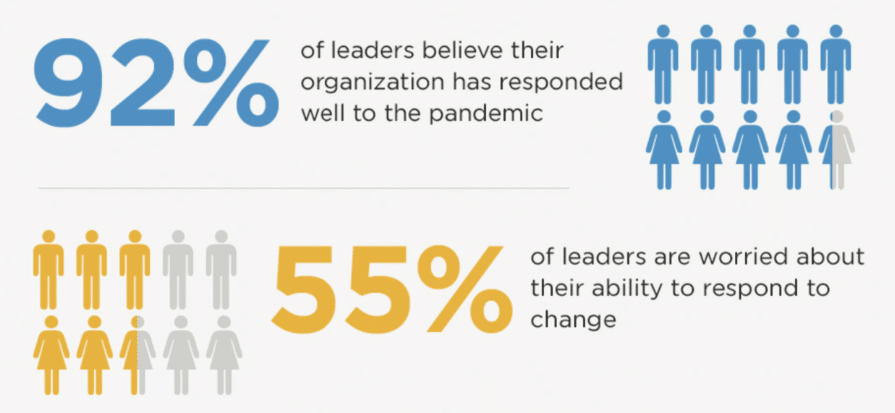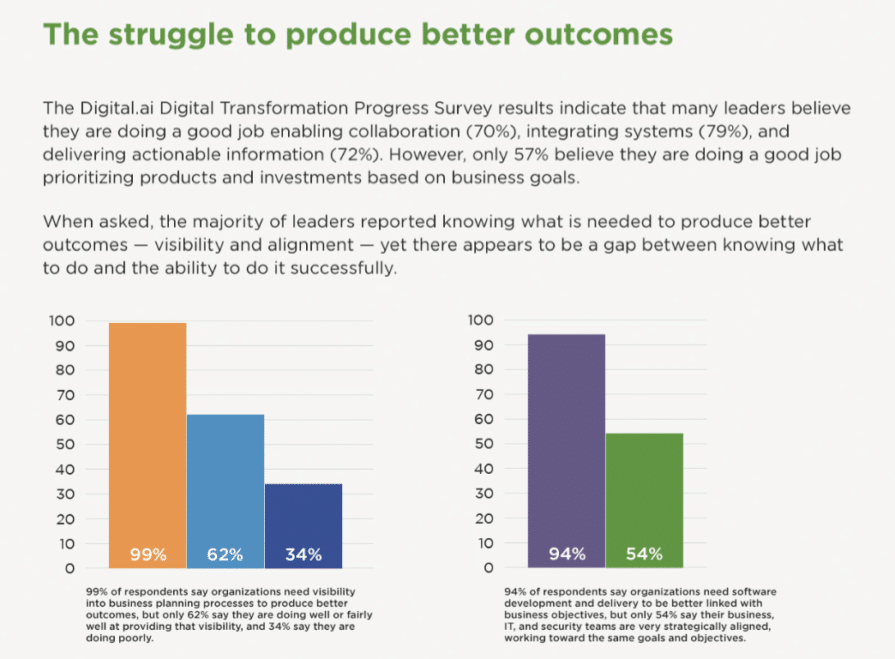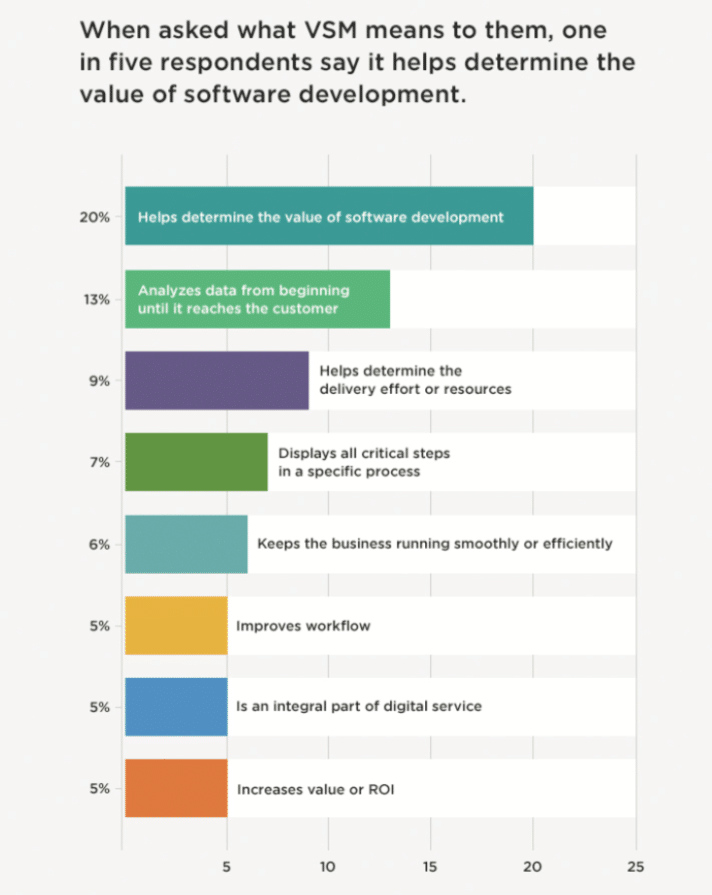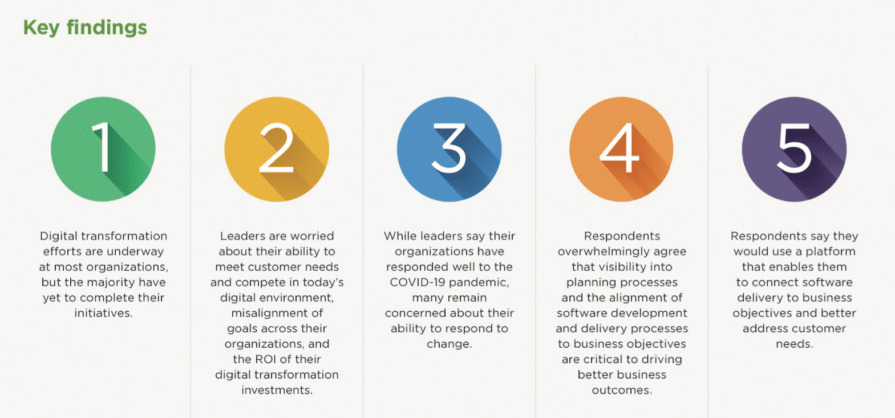Visibility into planning processes and the alignment of software development and delivery processes to business objectives are critical to driving better outcomes. But new research from value stream platform creator Digital.ai finds that more than half of enterprise IT, security, and business decision makers surveyed reported issues providing that visibility and alignment, calling into question the long-term success of today’s digital transformation initiatives.
The firm’s newly released Digital Transformation Progress Report details the findings of a survey of leaders on the state of digital transformation in their business during the COVID-19 pandemic, and reveals a wide range of issues relating to digital transformation, including concerns about ROI, security, and the ability to compete in today’s digital environment.
The overwhelming majority (99 percent) of leaders agreed that organizations need visibility into business planning processes to produce better outcomes, but only 62 percent said they can provide that visibility and 34 percent admitted they are doing poorly at providing visibility. Additionally, 94 percent of respondents said organizations need software development and delivery to be better linked with business objectives, but only 54 percent said their Business, IT, and Security teams are strategically aligned and working toward the same goals and objectives. What’s more, 78 percent of leaders said COVID-19 has further impacted the alignment between business and IT value streams in their organizations.
“Most of today’s Agile and DevOps tools are designed for the workgroup, making visibility and alignment fairly easy to achieve at the team level. However, scaling to the enterprise is far more complex, as organizations must break down silos and manage teams of teams that embrace different cultures, tools, and systems,” said Derek Langone, Head of Strategic Transformation at Digital.ai, in a news release. “We’ve found that in large enterprises that succeed at true digital transformation, business and technology teams work collaboratively to define value and drive outcomes. These companies typically organize themselves in terms of value streams, employ an open approach to sharing information, and leverage enterprise-grade solutions that offer full visibility and rich, predictive insights across the entire organization.”
Value stream management
While 94 percent of respondents said they are familiar with the concept of value stream management, and 95 percent believe their organization is definitely or probably practicing value stream management, only about half (53 percent) of the organizations said their business and software value streams are very aligned, and just 60 percent say their organizations are very customer centric. Moreover, there was no clear consensus on what value stream management means to the enterprise.
Gartner predicts that “by 2023, 70 percent of organizations will use value stream management to improve flow in the DevOps pipeline, leading to faster delivery of customer value and the use of value stream delivery platforms to streamline application delivery will grow from 10 percent to 40 percent.” Ninety-eight percent of survey respondents reported they are likely to use a platform that connects software delivery process to business objectives and provides insights needed to make decisions that increase value delivered to customers, and 63 percent said they would be very likely to use such a platform.
“The gap between investing in business transformation versus reaping the benefits has always existed but has been heightened in the last year,” said Alan Brown, author and professor in digital economy at the University of Exeter specializing in agile approaches to business transformation, in the release. “At the heart of it, digital or business transformation is not about doing everything faster, but about doing more of the right things efficiently. Automation and Value Stream platforms can go a long way to help organizations overcome key obstacles and enable them to achieve more of the intended results of digital transformation.”
Additional findings
Although most leaders said digital transformation was going well at their organization, the survey also found the majority have serious concerns about the state of their programs:
- 91 percent said they need to get more out of their digital transformation initiatives,
- 49 percent are not seeing the results they expected from their digital transformation initiatives,
- 56 percent are worried about the return on their digital transformation investment,
- 63 percent are worried about releasing security vulnerable products, and
- 54 percent believe problems with digital transformation have hurt their company’s bottom line.
With regard to the COVID-19 pandemic, the majority of leaders said their organizations have responded well to the situation. However, when asked, more than half (55 percent) are concerned about their organization’s ability to respond to change and their ability to compete in today’s digital environment (54 percent).
Download the full report here.
This survey was commissioned by Digital.ai and conducted by Regina Corso Consulting. The survey reflects the input of 600 total respondents: 200 IT decision makers, 200 Security decisions makers, and 200 Business executives. All respondents are solution practitioners or technical leads or higher, at least somewhat involved in the digital transformation efforts at their company, and work in a company with at least 500 employees. This survey was conducted online between December 8th and December 18th, 2020.












